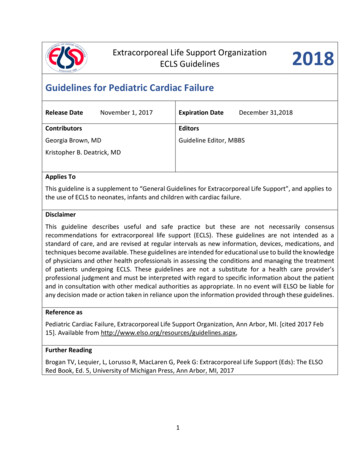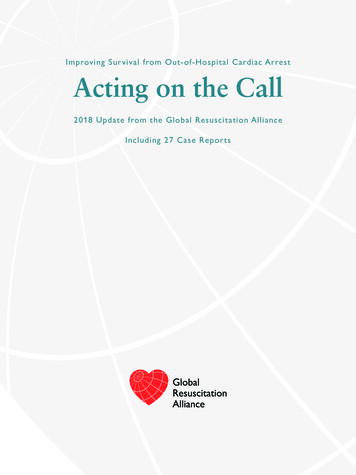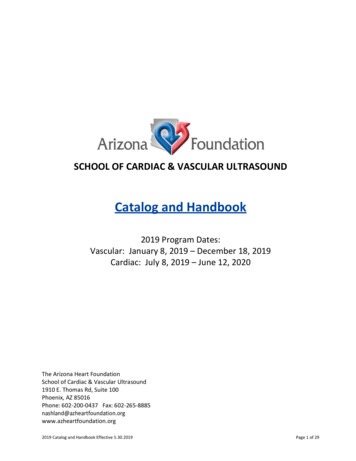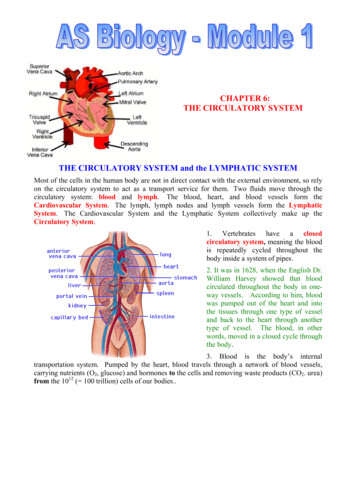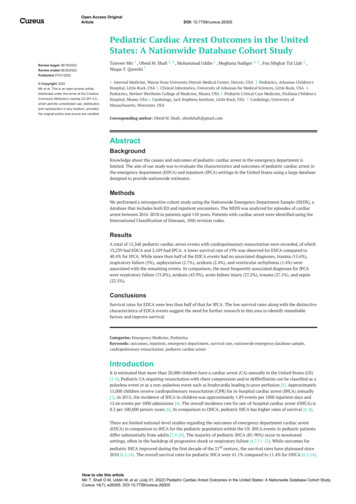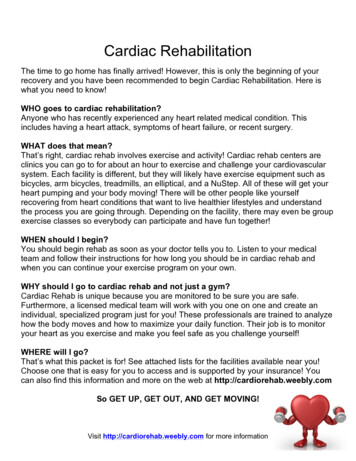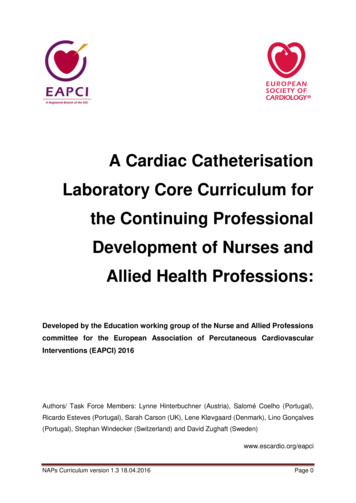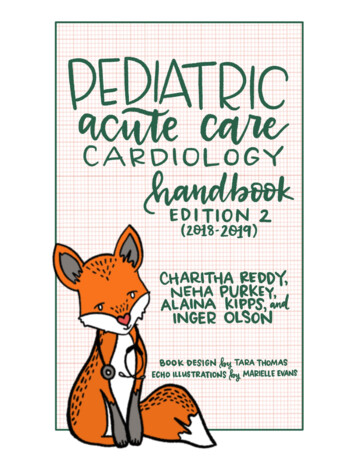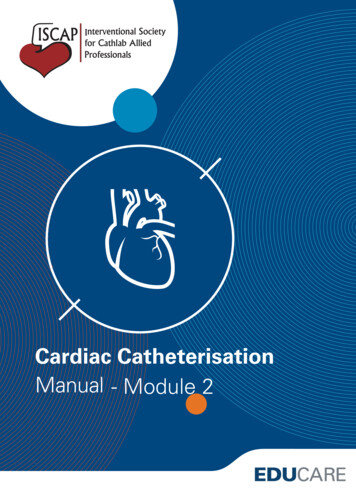
Transcription
Cardiac CatheterisationManual - Module 2
Cardiac Catheterisation ManualPage 2
First published 2014Copyright Interventional Society ofCath Lab Allied Professionals (ISCAP)Language & Content Owner:ISCAP (Interventional Society of Cath Lab Allied Professionals) is anactive Working Group of the South African Society of CardiovascularInterventions (SASCI)Online Services:Boston Scientificwww.virtualtraininginstitute.comAll rights reserved.While every effort has been made to ensure accuracy of the informationin this book, development of new knowledge and understanding ofcardiology as a whole may render obsolete some of the informationand opinions expressed herein. Health care practitioners mustalways assess the best clinical context in which to be taken and makejudgements regarding technique, diagnosis and therapy accordingly.The author, publisher, editors or others involved in the production ofthis book assume no liability for any injury or consequence of actionsresulting from the use of material contained within.Should one notice unintentional errors, or any information that couldimprove the content within, please connect with the ISCAP memberswithin the editorials to suggest these improvements.No part of this publication may be reproduced or transmitted in anyform or by any means without the permission of the authors and ISCAP.This includes the reproduction of single pictures or parts of the text inmagazines or newspapers for public events, filming or broadcastingon radio or television or any other media.Page 3
ForewordWhere once we were amurmur, we now havethe opportunity to findour own rhythm and become thetrue heart of the cath lab.Though the quality of South African Cardiologyhas always been on a par with the rest of theworld, the training of professional nurses,technologists and radiographers (AlliedProfessionals), in the highly specialisedfield of cardiovascular intervention hasbeen neglected. Our country has lackedguidelines that describe the requirements fora cardiovascular interventional laboratory tobe managed successfully. There continues tobe no official course to provide credentialing inthe subject to the registered nurse.The national Interventional Society of Cath LabAllied Professionals (ISCAP) aims to uphold ahigh standard of cardiovascular interventionallaboratory practice and improve the standingof the nursing and allied professional workingwithin that environment. By these means ourmembers will gain recognition as importantparticipants in patient management within thecardiovascular interventional laboratory.This second edition of the Cath Lab Manual isthe continuation of this process. The Manualhas been written for all those who work inthe cardiovascular interventional laboratory,both as an introductory aid for the novice andas a reliable reference for the experiencedpractitioner.By ensuring that educational material suchas this is available on line and in hard copy ,we are enabling ourselves to assume greaterresponsibility for our staff’s development andour own job satisfaction. We also hope that theoverall morale will also be enhanced.CPD points will be attainable for those whowish to complete the questions at the end ofeach Chapter. There will also be a componentwhereby we can share information andexperiences on line.We need to equip staff with the knowledgeand specific skills necessary for invasivephysiology and anatomical assessment, alsofor the diagnosis and management of coronaryand structural disease.We trust you will find the Manual helpful. Welook forward to hearing your comments andcriticisms, so as to contribute to the greatervalue of this ongoing process of sharinginformation and thus learning from each other.If you want to goquickly, go alone.If you want to go far gotogether African proverbCardiac Catheterisation ManualPage 4
AcknowledgementsSincere thanks to all who contributed to thecompilation and production of this manual,especially the following contributors:Dianne KerriganGill LonganoWaheeda Howell – Chairperson ISCAP 2018Cobus BadenhorstAnthony DalbyJudith DanielsLorraine LubbeIn Memoria - Jaco ReineckeEditorial PanelAll new content is to be reviewed as it iscreated and thereafter approved by thepanel below. This is for all digital and printversions.SASCIDave Kettles, MDSASCI PresidentCobus BadenhorstSASCI Executive - Cardiologist ContributorISCAPDianne KerriganISCAP also wishes to extend a specialthanks to:Chief Medical Contributor: Allied ProfessionalGillian LonganoMedical Contributor: Allied ProfessionalSCAIJames C. Blankenship, MDSCAI PresidentWhose dedicated support from the entireteam significantly contributed to the newdigital edition of this manual as well ascontent review.BOSTON SCIENTIFIC EDUCAREJayesh Jani, MDMedical Director, Boston Scientific APACAmy GokerInstitute for Advancing Science Manager,Boston ScientificPage 5
ContentsModule 22.1 The Roles and Responsibilities of the Cath Lab Team82.2 Indications and Contraindications for Coronary Angiography122.3 Basic Concepts in Cardiac Catheterisation162.4 Asepsis in the Cardiac Catheterisation Laboratory292.5 Bibliography38Cardiac Catheterisation ManualPage 6
Page 7
Module 22.1 The Roles and Responsibilitiesof the Cath Lab TeamThe cath lab may differ depending on thethe cath lab does paediatric cardiac studies andcountry and also the individual hospitalprocedures.groups or institution.In most centres inSouth Africa, the Electrophysiology laboratory (EPThere are 4 broad categories pf tasks performed byLab) has its own specialised team. Some cardiacthe cath lab team: scrub, floor person, technologistcatheterisation laboratories have grown into(monitoring ), radiographer (fluoro). Other duties“heart and vascular institutes,” performing notmay include the anaesthetic nurse if there is anonly cardiac procedures but also endovascularanaesthetist present, and a person who does theprocedures (peripheral, carotid, and cranial).charging of equipment and stock control. Nursingstaff are often required to capture the stock andThe exciting news is that once you have a broadvital signs of the patient, on the computer, asknowledge base and have a high degree of manualdigitisation is the future.dexterity and the ability to work in emergencysituations you are able to move in your career spanPATIENT PREPARATIONthrough all these areas. Apart from endovascularAs the patient is helped onto the X-ray table,even the medical technologists can experience EPa description of the X-ray tube, monitors, andlab and cath lab. The radiographers are alreadyprocedure table is helpful in decreasing the anxietyworking in all these areas.in some patients.The procedure room can be filledwith lots of equipment and can be overwhelming.A nurse that has worked in EP Lab or cath labcan easily adapt to the hybrid lab and do theThe scrub and floor nurse will have obtained aendovascular procedures. The hybrid lab isfairly good picture of the patients state of mind.becoming part of the cardio-thoracic operatingA nervous patient is often very talkative. Sometheatre so more theatre staff can choose tocan even be aggressive towards the staff. Thecirculate through these areas during their workingnurse should listen as much as time allows. Thecareer. Another opportunity to cross-pollinate staffnurse should also try to learn if the patient has anyin these areas. In the future these nurses could bespecific worries that can be cleared up.the new HYBRID Nurse!An anxious patient tends not to talk and givesNurses and allied staff (technologists andonly the shortest possible answer to anyradiographers) should hold certification in basicquestion. It is important that the patient receiveslife support (BLS), advanced life support (ACLS),adequate reassurance from the nurse, both inand paediatric advanced life support (PALS), ifmanner and words. The staff should make sureCardiac Catheterisation ManualPage 8
that the anxious patient are informed about theirto explain to the patient why it is prolonged and ifprocedure and the reasons for it, even if they havethere is a complication.heard the explanation before. The nurse’s mannershould show that the nurse is both competent andCARDIAC TECHNOLOGISTconfident, that the procedure is routine, and that allThe cardiac technologists in private hospital cathpossible care will be taken.labs are self-employed. (Registered with the HPCC)Health Professionals Council of SA.There are different levels of anxiety :–– Level 1 : Diazepam 5mgms and reassuranceRoles and Responsibilities:–– Level 2 :Diazepam 5mgms and a good dose of Setsreassurance!–– Level 3: Conscious sedation - Fentanyl andDormicum as required - Sedationists–– Level 4 : General Anaestheticupthehaemodynamicmonitoringequipment. Set up the bridge in plenty oflight so that you can see the bubbles/air in theconnections in the transducer. She/he also checks the Intravascular ultrasound(IVUS), Instant wave-free ratio (IFR), OpticalA cath lab needs to have friendly, positive staff toCoherence Tomography (OCT) consoles, intra-boost the patients confidence. The patient gets theaortic balloon pump (IABP), temporary pacingimpression that the staff are competent and theylead and pacing box.enjoy their work. This allows them to relax enoughto place themselves in the hands of the staff for theduration of the procedure. Assists and guides the cardiologist on IVUS,IFRand OCT measurements and findings. Understands the risks associated with theprocedures and knows how to trouble-shoot forThe right amount of sedation can be of benefit tomachines eg. rotoblator.both the patient and the team, as the patient can Checks the defibrillator and ensures that there arebecome restless and agitated, if over-sedated.defibrillator and pacing pads available. TrainedEnough sedation allows the patient to be awarealso to activate the defibrillator when required.and to inform the staff if they are feeling pain Connects patient to haemodynamic monitoringor discomfort. The patient is often aware of aequipment and monitors the patient continuously,complication before we notice it on the monitor orproviding records of monitored data.X-ray screen. Recording of patients vital signs: heart rate andrhythm, respiratory rate, peripheral saturation,The floor person should talk to the patient as oftenblood pressure.To record and inform cardiologistas is practical. This is reminds everyone includingif there is ST elevation,depression, T wavethe cardiologist that the patient is awake and ableinversion etc.to hear everything that is going on. Alerts the cardiologist if there is any changeIf the patient preparation has been thorough, therein patient’s condition.To be aware and recordshould be little that has to be done for him orpre-angiogramher during a procedure of normal duration. If theangiographic measurements.procedure is prolonged then the cardiologist needshaemodynamicsandpost- Recording of all procedural measurements,Page 9
stents, balloons and inflation device pressures inhave two RPC Meetings annually.order to compile a detailed procedural record . Acopy of this record is required by the cardiologistThe radiographer plays an important role in theand for the hospital file. We attach it to the Peri-cath lab, and can become experts in this field.Operative form. If your hospital is digitalised thenit is automatically captured onto the system.The length of the procedure can be reduced when Assists with cardiopulmonary resuscitation.the radiographer uses her/his knowledge and To have knowledge of products used in the cathexperience to produce the right views so that thelab.cardiologists can identify and locate the lesion/ Attends Continuous Professional developmentmeetings to stay up to date with the latestlesions as quickly as possible, and then carry outthe procedure and intervention timeously.procedures, products and knowledge (guidelinesKey areas:etc). Patient careRADIOGRAPHER Use of technology – quality assuranceIn South Africa, a radiologist or radiographer is Optimisation of doserequired to sign the Licence for the x-ray equipment. Clinical responsibilityThe Holder of the Licence remains the responsibility Organisationof the Hospital Manager. The radiographers in most Education and trainingprivate hospital cath labs are self-employed.It is a requirement that diagnostic x-ray units in cathRoles and Responsibilities: may vary dependinglab are operated by a qualified radiographer who ison the country and hospital.registered with Health Professional Council. EnsuresCardiologists are not allowed to operate the x-rayunits in South Africa, although he Europe it iscommon practice.thesmoothoperationofallradiographic equipment. eredclinicalradiationprocedures.Basic radiation training should be given to Be familiar with and adhere to all DoH DRCcardiologists, surgeons, nursing staff, technologistsregulations and requirements. ( Code ofand other non-radiation workers involved in cathPracitice & Requirements for License Holders).lab and hybrid theatres. A refresher course should Be familiar with and implement As Low Asbe available to those who have worked for a longReasonably Achievableperiod in the labs. These can be organised with theand techniques.(ALARA) principlesMedical Physicist responsible for that area.(Private Keeps a Radiography Patient Record;Hospitals). Reports any incidents or accidents to thehospitalRadiation Safety Officer. IncidentEach cath lab should have a Radiation Protectionform to be completed immediately, whenCommittee (RPC) organised, and are required tothe doses are above 30,000. Ensures that theCardiac Catheterisation ManualPage 10
cardiologists is aware of high dose so that he/or a vascular seal has been used. The TR band orshe can keep track of the patient.Quikclot may be used to apply pressure on the Does daily basic quality checks on themachines and informs the Unit Manager ifradial /ulnar artery, once the sheath has beengently removed.there are problems. There is also a form forWeekly Basic QA Records.If the sheath in the groin, is not to be removed Performs all tasks related to diagnosticimmediately following the procedure, the arearadiology: setting up of the injector, lesionshould be cleaned with saline covered with anquantification. ( This may differ depending onopsite dressing. The nurse should inform thethe country and the cath lab).patient when the dressing will be removed, and Ensuresgoodqualityexaminationsandappropriate views to identify the lesions.how important it is not to move the limb that wehave worked on.This can assist the cardiologists in decisionmaking and the amount of time spent doingPatients must be given verbal and writtenthe procedure. Also, a radiographer who isinstructions regarding post procedure care.proficient with views can reduce the amountof contrast used. Focuses cardiologists attention to problems(e.g dissection of vessel) during the case.Invasive Cardiology – A Manual for cath lab personnel.Third edition Sandy Watson RN,BN,NFESCKenneth A. Gorski RN, RCIS, RCSA, FSICP Manage patient radiation doses within safelimits and participate in the Dose OptimisationROLE OF SCRUB SISTER: ASSISTANT TO THEProgrammes. (DAP)DOCTOR Screens lead aprons/thyroid shields everyA procedure done in the cath lab often requires12 months. Cracked lead aprons, shields aretoo many complex psychomotor demands for onedisposed of in the right manner.set of hands, and scrub nurses/assistants are the Index book with record of cases so that it isquick to access patient data. If the cath lab still archives the CD’s: files theCD’s under the individual cardiologists. Reminds staff and cardiologists to be aware ofcardiologists right hand.They must anticipate thecardiologists needs and be prepared to changecourse rapidly.They must maintain a strictsterile field and properly prepare the equipmentper manufacturer and hospital protocol.radiation scatter and to wear their dosimetersand lead protection.PROCEDURE OBJECTIVES: Participate as a member of the Hospital To introduce her/himself to the patient, andRadiation protection committee and attend theto check Peri-operative Checklist -Pause Formmeetings when required.with the patient. To ensure that safety to patient and staff isPROCEDURE COMPLETIONmaintained throughout the procedure, and toThe pressure bandage may need to be applied tobe aware of any risks that may contribute tothe groin if manual compression has been appliedcomplications eg. bleeding problems.Page 11
To ensure that correct equipment is openedand to anticipate what will be required next. To observe patient and doctors movementsand to be aware of the x-ray and monitoring5. Prepare trolley and equipment – to use hibitanesolution (non-iodine solution) if patient isallergic to iodine/contrast.6. Identify all drugs on the trolley preferablyscreens. To anticipate what the next step in the plan willbe and to prepare timeously . Multi-tasking:betadine solution.toassistthewith labels if possible. When in doubt of amedication, dispose of it.cardiologist,observe the haemodynamic pressures, ECG.7. Check that the O2 satuation is satisfactorybefore sedation is administered. Also, has thepatient had adequate sedation, if there is noPRE – PROCEDURE:anaesthetist.1. Pause Form to be completed. This informs8. To know if patient has had anti-coagulantthe assistant and staff of the patient’s historytherapy, so that the plan to use to a closureand the risks that may be associated withdevice if the groin is used is confirmed.the procedure. eg. diabeteic, anticoagulants,previous procedures.9. Check all equipment is correct that is openedonto trolley2. Adequate radiation protection – thyroid/gown,INTRA-OPERATIVE:head/glove3. Gown & glove – mask (optional)4. Before cleaning the patient check again that1. Always preflush catheters and store themthey are not allergic to iodine, if you are using a2. Never force equipment( guidewire or catheter),carefully so that they don’t spring off the table.into the patient. If resistance is met, stop;evaluate the situation and assess the patient.Cardiac Catheterisation ManualPage 12
3. Always hold the syringes with the tip down, andaspirate a small amount of blood immediatelyensure that they are titrated correctly.15. Observe carefully to prevent complicationsprior to flushing. Tip the syringe so that anyor unnecessary events happening e.g –wiresbubbles will rise, reducing the chance of airfalling on floor, injecting when pressure isembolism.down, wire dissecting the artery4. Stand back when doctor is gaining access thatyou are not splashed by blood.5. Be aware of sharps – dispose of sharpsimmediately if patient has HIV/CRE6. Check that equipment is in good working order– no faulty equipment7. To ensure that the patient is comfortable andstablePOST- PROCEDURE:1. If closure device is used, check that there is noresidual oozing. Apply pressure bandage orradial artery dressing/TR band.2. Check for pedal/dorsal pulses if femoral arterypuncture.8. To observe the pressures and ECG before3. Check colour warm & sensation for radial arteryinjecting contrast, and watch how the contrastcompression device. If radial artery pulse isdisperses in the heart. Warn the patient wheneasy to access - check. Show the patient howhe/she may feel a hot flush and will feel liketo compress the radial artery also.they are passing urine, (wetting the bed). Thisalso allays anxiety in the patient.4. Complete Radial Checklist form.5. Pressure dressing/bandages to be applied.9. If the pressures drop with contrast injection ofthe RCA then ask the patient to cough, to clearPOSTthe contrast quickly. Observe the ECG carefully.INSTRUCTIONS:10. Check patient if he/she is restless – consciousstate and level of pain11. Anticipate the equipment that will be requiredfor the procedure, and have it prepared andready.12. Do not force the wire or catheters, whenPROCEDURE-EDUCATIONAND1. Ensure that staff on the ward/CCU have beeneducated on the post-procedure care – femoral/radial access.2. Patient information sheets to given to patient.3. Verbal instructions to be given also. Ensurethat patients understand themadvancing them in the patient.13. Always suck back on the sheath side-armbefore flushing in saline ( if clot is present insyringe, suck again and check that patientdoes not require heparin) .14. Do not inject medication directly into catheter,eg, nitrocene or adenocor directly –Page 13
2.2 Indications and Contraindications forCoronary AngiographyCardiac catheterisation is an umbrellasegment elevation should be less than 90 minutesterm for all aspects of right and left heart(ACC:2012).catheterisation from any percutaneousINDICATIONS FOR CORONARY ANGIOGRAPHYroute.The most current guidelines for diagnosticCoronary angiography is the term used tocoronary angiography, reported by a joint Taskindicate selective right and left coronary arteryForce of the American College of Cardiologycannulation. Non-coronary angiography refers to(2012) and the American Heart Association (2012),aortagraphy, pulmonary and renal angiography.divide the indications for coronary angiographyinto 3 classes:Coronary angiography is a powerful tool for riskstratification during acute myocardial infarctionClass I:(MI)revascularisation.Conditions for which there is evidence and/orEmergency coronary angiography with the intentgeneral agreement that the procedure is usefulto perform primary percutaneous coronaryand effective.andforfacilitatingintervention is applicable to most patientspresenting within 12 hours of an acute ST-segmentClass II:elevation (STEMI) or new left bundle branch blockConditions for which there is conflicting evidence(American Heart Association: 2012). This strategyand/or a divergence of opinion about thecan also be applied to patients with non-STEMIusefulness/efficacy of performing the procedure.who have persistent or recurrent symptomsdespite optimal medical therapy or high riskClass III:features which include: elevated troponin, newConditions for which there is evidence and/orST-segment depression signs, symptoms ofgeneral agreement that the procedure is namic orelectrical instability, and prior revascularisation.Patients with persistent chest pain or ST-segmentelevation following fibrinolytic therapy shouldalso undergo angiography with the intent toperformprimarypercutaneousintervention.Patients who are successfully resuscitated fromsudden cardiac death have a high probabilityof underlying coronary disease and warrant acoronary angiogram (Joint Commission:2012).Ideally, door-to-balloon time in patients with ST-Cardiac Catheterisation ManualPage 14
CLASS I - THESE PATIENTS SHOULD HAVE A CARDIAC CATHETERISATION PROCEDURE.UNSTABLE CORONARY SYNDROMES Unstable angina/ACS (Acute Coronary Syndrome) refractory to medical therapy or recurrent symptomsafter initial medical therapy Unstable angina/ACS with high risk indicators Unstable angina/ACS initially at low short-term risk, with subsequent high-risk non-invasive testing Prinzmetal angina with ST-segment elevation Suspected acute or sub-acute stent thrombosis after percutaneous coronorary intervention (PCI)ANGINA High-risk non-invasive testing Canadian Cardiovascular Society class III or IV angina on medical therapy Recurrent angina 9 months after PCIACUTE MYOCARDIAL INFARCTION Intended PCI in acute STEMI or new left bundle branch block (LBBB): Within 12 hours of symptom onset–– Ischaemic symptoms persisting after 12 hours of symptom onset–– Cardiogenic shock in candidates for revascularisation–– Persistent haemodynamic or electrical instability Angiography in non-STEMI–– As part of an early invasive strategy in high-risk patients (positive Trop-t, ST-segment changes,congestive heart failure (CHF), haemodynamic/electrical instability, recent revascularisation)–– Persistent/recurrent symptomatic ischaemia with or without associated ECG changes despite antiischaemic therapy–– Resting ischaemia or ischaemia provoked by minimal exertion following infarction–– Prior to surgical repair of a mechanical complication of MI in a sufficiently stable patientPERI-OPERATIVE RISK STRATIFICATION FOR NON-CARDIAC SURGERY High-risk non-invasive testing Unstable angina or angina unresponsive to medical therapy Equivocal non-invasive test result in patient with high clinical risk undergoing high-risk surgeryCONGESTIVE HEART FAILURE Systolic dysfunction associated with angina, regional wall motion abnormalities or ischaemia on noninvasive testingPage 15
OTHER CONDITIONS Valvular surgery in patients with angina, significant risk factors for coronary artery disease (CAD) orabnormal non-invasive testing Valvular surgery in men 35 years or older, any post-menopausal women and pre-menopausal women 35and older with cardiac risk factors Correction of congenial heart disease in patients with angina, high-risk non-invasive testing, any form ofcongenial heart disease frequently associated with coronary artery anomalies, or in those with knowncoronary anomalies After successful resuscitation from sudden cardiac death, sustained monomorphic ventricular tachycardia,or non-sustained polymorphic ventricular tachycardia Infective endocarditis with evidence of coronary embolisation Diseases of the aorta necessitating knowledge of concomitant coronary disease Hypertrophic cardiomyopathy with anginaCLASS II - THESE PATIENTS MAY BE CONSIDERED FOR A CARDIAC CATHETERISATIONPROCEDURE.ANGINA CCS (Canadian Cardiovascular Society) class I or II, EF 45% and abnormal but not high-risk non-invasivetesting Patients with an uncertain diagnosis after non-invasive testing in whom the benefits of the procedureoutweighs the risk Patient who cannot be risk stratified by other means Patients in whom non-atherosclerotic causes such as anomalous coronary artery, radiation vasculopathy,coronary dissection etc. are suspected Recurrent angina/symptomatic ischaemia within 12 months of coronary artery bypass graft (CABG) Recurrent angina poorly controlled with medical therapy after revascularisation Patients with CHF who have chest pain, have not had evaluation of their coronary anatomy, and do nothave contraindications to revascularisationACUTE MI MI suspected to have occurred by a mechanism other than thrombotic occlusion of atherosclerotic plaque(coronary embolism, arteritis, trauma, coronary spasm) Failed thrombolysis with planned rescue PCI Post-MI with ejective fraction (EF) 40%, CHF, or malignant dysrythmias CHF during acute episode with subsequent demonstration of LVEF 40% Patients with recurrent acute coronary syndromes (ACS) despite therapy without high-risk featuresCardiac Catheterisation ManualPage 16
PERI-OPERATIVE RISK STRATIFICATION FOR NON-CARDIAC SURGERY Planned vascular surgery with multiple intermediate clinical risk factors Moderate-large region of ischaemia on stress test without high-risk features or decreased EF Equivocal non-invasive testing in patient with intermediate clinical risk undergoing high-risk surgery Urgent non-cardiac surgery while recovering from an acute myocardial infarction (MI)OTHER CONDITIONS Systolic left ventricular (LV) dysfunction with unexplained cause after non-invasive testing Episodic CHF with normal LV systolic function with suspicion for ischaemia-mediated LV dysfunction Before corrective surgery for congenital heart disease in patients whose risk factors increase likeli hoodof CAD Recent blunt chest trauma and suspicion for acute MI Before surgery for aortic dissection / aneurysm Periodic follow-up after cardiac transplantation or for prospective immediate cardiac transplant donors Asymptomatic patients with Kawasaki disease and coronary artery aneurysms on echocardiographyCLASS III - THE CARDIOLOGIST MUST WEIGH UP THE RISKS OF THE PATIENTUNDERGOING A CARDIAC CATHETERISATION PROCEDURE.UNSTABLE ANGINA Symptoms suggestive of unstable angina but without objective signs of ischaemia and with normalcoronary angiogram during the past 5 years Unstable angina in patients who are not revascularisation candidates or for whom revascularisation willnot improve the quality or duration of life Unstable angina in a post-bypass patient who is not a revascularisation candidate Patients with extensive co-morbidities in whom risks of revascularisation likely outweigh the benefitsANGINA AND CAD Angina in patients who do not desire revascularisation Screening test for CAD in asymptomatic patients Patients with co-morbidity in whom the risk outweighs the benefit of the procedure Provocative testing in patients with high-grade obstructive disease Non-specific chest pain with normal non-invasive testing Patients with CCS class I or II responsive to medical therapy with no ischaemia on non-invasive testing Routine angiography in asymptomatic patients after PCI or CABG (except in unprotected left main arteryPCI in which angiographic follow-up in 2 – 6 months is reasonable)MI: STEMI OR NEW LBBB Patients beyond 12 hours from symptom onset who have no evidence of ongoing ischaemiaPage 17
After thrombolytic therapy with no evidence of ongoing ischaemia Routine angiography and PCI within 24 hours of thrombolytic therapy Patients with extensive co-morbidities in whom risk of revascularisation likely outweighs benefitsALL MI: HOSPITAL MANAGEMENT AND RISK STRATIFICATION PHASE Patients who are not revascularisation candidates or do not desire revascularisationPERI-OPERATIVE RISK STRATIFICATION FOR NON-CARDIAC SURGERY Low-risk surgery with known CAD and no high-risk results on non-invasive testing Asymptomatic after revascularisation with excellent exercise capacity Mild stable angina, good left ventricular function, and not high risk by non-invasive testing Patients who are not candidates for revascularisation or do not desire revascularisation Part of work-up
In the future these nurses could be the new HYBRID Nurse! Nurses and allied staff (technologists and radiographers) should hold certification in basic life support (BLS), advanced life support (ACLS), and paediatric advanced life support (PALS), if . Conscious sedation - Fentanyl and Dormicum as required - Sedationists - Level 4 : General .
